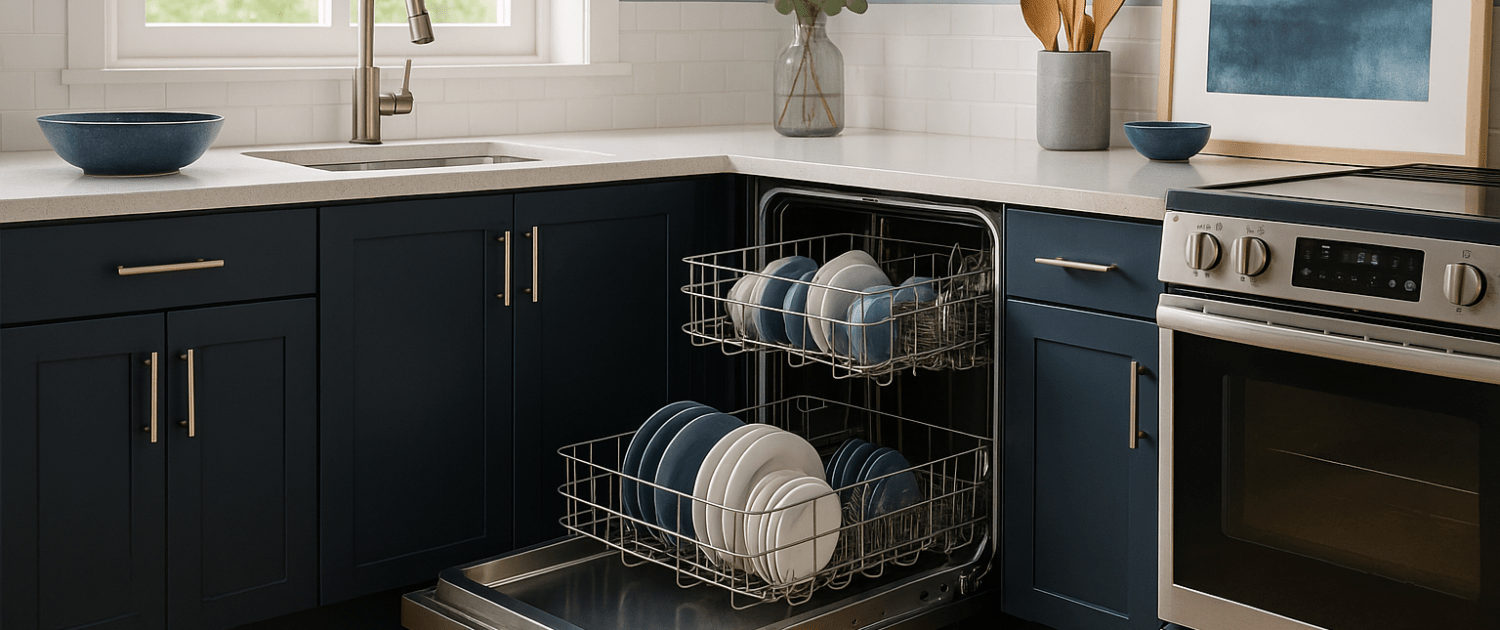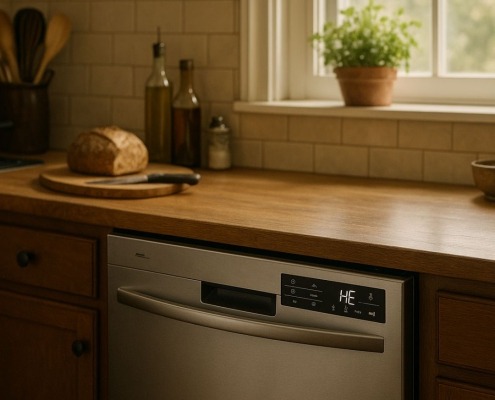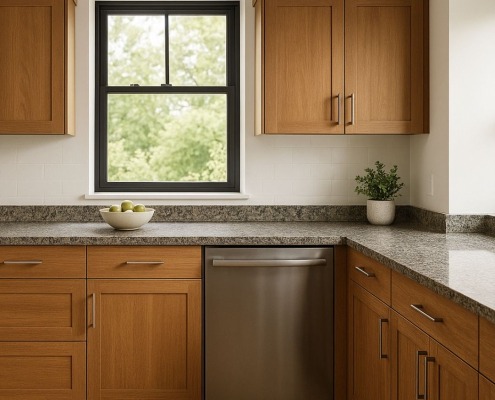DIY Guide to Fix a Tilting Dishwasher Step by Step
Steven E / Monday May 12, 2025
You pull open your dishwasher door to unload the clean dishes after a wash cycle. But as soon as you slide out the rack, the whole dishwasher pitches dangerously forward! A dishwasher tilting forward when opened is not only annoying but also hazardous. Luckily, with some basic troubleshooting and adjustments, a tilting dishwasher repair is easy to accomplish.
We’ll cover the common causes of dishwashers that lean or tip over when the door is opened. You’ll learn clear steps on how to diagnose and repair mounting, leveling, and stability issues. With the right repairs, you can stop your dishwasher from tilting forward unexpectedly and ensure it opens smoothly.
The information in this article may not apply to your specific appliance model. We recommend consulting your manufacturer’s documentation or contact us with any questions.
Why Does My Dishwasher Tip When I Open It?
Before diving into fixes, let’s look at the main reasons a dishwasher rocks forward or loses balance when you pull the door open:
- Uneven leveling legs – Dishwashers have adjustable front leveling feet that are used to make sure the unit sits perfectly level. If one foot is set lower, it throws off the balance.
- A loose mounting bracket – Mounting brackets anchor the dishwasher under the counter. If they come loose or detach, the dishwasher can tip when opened.
- Misaligned rear rollers – Some models have rear wheels or rollers that need to be evenly adjusted. Improper roller height can lead to tilting.
- Uneven flooring – Dips, gaps, or slopes in the flooring under the dishwasher can cause rocking when weight shifts.
- Improper loading – Dishes loaded unevenly front-to-back or side-to-side lead to unbalanced weight distribution inside, which can worsen tipping.
Understanding the root causes of a tipping dishwasher will help guide your troubleshooting steps. Now let’s look at how to diagnose and repair this issue in your machine.
Inspecting the Dishwasher Leveling Legs
One of the first things to check with a tilting dishwasher is ensuring the front leveling legs are adjusted correctly. Levelers are located on the bottom corners of the dishwasher and can be turned with a wrench to raise or lower each side.
To check and adjust the legs:
- Use a bubble level to verify the dishwasher is uneven. Place on the front opening to see if one side is higher.
- Lay on the floor to access the front leveling feet. Use a wrench to turn the legs in small increments.
- Turn the lower leg clockwise to raise that side until the bubble shows the dishwasher is perfectly level.
- Open and close the door to confirm the dishwasher no longer tips or rocks.
- Adjust legs evenly until leveling is stable. Check the flooring under the unit for unevenness as well.
Getting the front legs precisely leveled from side to side will go a long way toward stabilizing your dishwasher and stopping it from tipping over when opened and shut.
Checking the Mounting Brackets
Dishwasher mounting brackets are an important mechanism that helps keep the appliance secured under your countertops. The brackets attach to the top or sides if you have a granite countertop, of the dishwasher and then get screwed firmly into the underside of your kitchen counters.
If the mounting bracket works loose or falls off, it removes the anchor holding your dishwasher in place, which can lead to the dishwasher tilting forward when any weight or force is applied.
To inspect your dishwasher’s mounting brackets:
- Remove power to the dishwasher at the breaker. Verify power is off for safety.
- Carefully pull the dishwasher out from under your counters to access the top and upper sides.
- Check if the side mounting brackets or the top mounting brackets are present. Look for bracket mounting holes along the top or side frames.
- If brackets are present, check that all screws are tight. Tighten any loose screws with a screwdriver.
- Slide the dishwasher back into place, verifying the mounting holes align correctly.
Proper mounting is essential to keep your dishwasher from bouncing forward when opened and shut. Always take time to inspect the brackets and tighten screws during any dishwasher installation.
Adjusting the Rear Rollers
Some dishwasher models have small wheels or rollers at the rear bottom that are used to conveniently roll the dishwasher in and out during installation or repairs. These rear rollers should be checked to ensure they are level and evenly aligned.
To adjust rollers on a tilting dishwasher:
- Use a flashlight to locate the rear rollers under your unit if present.
- Use a wrench to loosen the locking nut on each roller bracket.
- Turn rollers upward or downward so they match the same height on each side.
- Tighten locking nuts once set to the proper height.
- Gently slide the dishwasher back, being careful not to kink hoses.
- Open and close the door to test if tilting improved. Further adjustments may be needed.
Having rollers properly set can improve stability and prevent uneven tilting when weight and force are applied to one side.
Checking Flooring and Using Shims
Dips, inconsistencies, or sloping in the flooring underneath your dishwasher is another source of rocking and tipping. The unit may pivot on uneven spots as weight shifts when opening and closing the door.
To improve a tilting dishwasher due to uneven flooring:
- Use a long level on the floor area under where the dishwasher sits.
- Identify any gaps or uneven areas under the dishwasher.
- Cut wood shims to the width and height needed to fill any low spots.
- Use a rubber mallet to tap the shims completely under the dishwasher to provide a flat surface.
- Test dishwasher stability after leveling with shims. Add shims until tipping stops.
Shimming is an effective way to level out dips and inconsistencies in the flooring that can lead to annoying dishwasher tilting.
Loading Dishes Properly
Another factor that can contribute to dishwasher tipping is uneven weight distribution inside from improper dish loading. Too many dishes crowded to one side, or loaded towards the front can cause imbalance.
When loading dishes, be sure to:
- Distribute dishware evenly left-to-right to balance side weight.
- Don’t overload one rack or leave the other empty, if possible.
- Stagger large items toward the back and center of the racks.
- Don’t cluster heavy pots, pans, or platters on one side.
Balanced loading helps prevent weight shift that makes tipping and rocking worse when the dishwasher door is opened and closed.
Where To Find Us
If you need any replacement parts for your appliances, you can enter your model number at AppliancePartsPros.com to locate and order them quickly. Most orders arrive in just two business days, and we have tons of great information in our repair help section and YouTube videos to help you troubleshoot.
Stay connected with the latest DIY tips, tutorial videos, and repair guides by following us on Facebook, Instagram, and Twitter. We love hearing about your repair stories and successes. If you need more help or want personalized guidance, feel free to reach out. We’re ready to help you take on your next project with confidence!
With nearly a decade of experience in providing top-notch customer service regarding appliance parts and repair, Steven enjoys sharing practical advice, troubleshooting tips, and interesting information to help readers stay informed.





